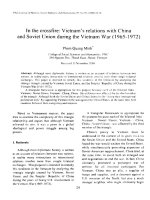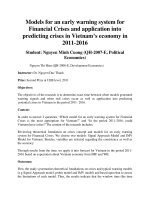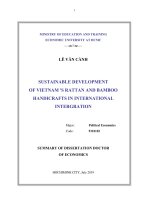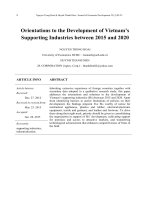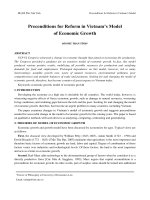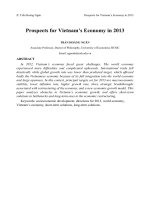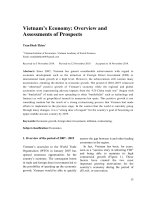GROUP ASSIGNMENT ANALYZING VIETNAM’S ECONOMY although GDP growth in 2020 is the lowest in the 2011 2020
Bạn đang xem bản rút gọn của tài liệu. Xem và tải ngay bản đầy đủ của tài liệu tại đây (727.62 KB, 22 trang )
DANANG UNVIVERSITY OF ECONOMICS
INTERNATIONAL BUSINESS
--------------------
GROUPASSIGNMENT
ANALYZING VIETNAM’S ECONOMY
Lecturer: Nguyen Son Tung
Class: 47k01.2
TIEU LUAN MOI download :
CONTENTS
1.
GDP..................................................................................................................................................... 3
2.
Unemployment rate............................................................................................................................ 8
3.
Balance of Trade.................................................................................................................................. 9
VietNam’s trade balance in 2020......................................................................................................... 9
VietNam’s trade balance in 2021......................................................................................................... 10
4.
Base interest rate.............................................................................................................................. 11
In 2020.................................................................................................................................................. 11
In 2021.................................................................................................................................................. 13
5.
CPI...................................................................................................................................................... 14
In 2020.................................................................................................................................................. 14
In 2021.................................................................................................................................................. 15
6.
Inflation............................................................................................................................................. 16
In 2020.................................................................................................................................................. 16
In 2021.................................................................................................................................................. 17
7.
Labor productivity.......................................................................................................................... 18
8.
Consumer spending........................................................................................................................... 19
In 2020.................................................................................................................................................. 19
TIEU LUAN MOI download :
1.
GDP
2020 is considered a year of great difficulties and challenges for the world economy in general,
including Vietnam. The world economy is forecasted to have the most severe recession in
history, and the growth of major economies will decrease deeply due to the negative impact of
the Covid-19 epidemic. However, Vietnam's economy still maintains growth with an estimated
GDP growth rate of 2.91%. (Tổng cục thống kê, 2021)
The Covid-19 epidemic has complicated developments, disrupting the ting social-economic
activities of countries worldwide; the US-China trade conflict continues. In Viet Nam, natural
disasters and epidemics have a significant impact on the activities of the economy and people's
lives; unemployment and underemployment rates are high. However, with drastic and effective
solutions in realizing the dual goal of "both disease prevention and socio-economic
development", Vietnam's economy still achieved positive results with maintaining growth.
Although GDP growth in 2020 is the lowest in the 2011-2020 period and suffering the negative
impacts of the Covid-19 epidemic, it is a success for our country with the highest growth rate in
the group of countries in the world.
(Tổng cục thống kê, 2021)
GDP growth rate for the years 2011-2020 respectively is: 6.24%, 5.25%; 5.42%;
5.98%; 6.68%; 6.21%; 6.81%; 7.08%; 7.02%; 2.91%.
TIEU LUAN MOI download :
(Ngọc Hà, 2020)
GDP in 2020 increased by 2.91% (in the first quarter, by 3.68%; in the second quarter
by 0.39%; in the third quarter by 2.69%; in the fourth quarter by 4.48%).
The GSO showed that the results mentioned above are due to the close inspection of
the Covid-19 epidemic, the gradual recovery of the skin to new normal conditions, and
the EVFTA agreement that took effect on August 1. Accordingly, economic growth in
the fourth quarter was 1.86 percentage points higher than in the third quarter. (Ngọc
Hà, 2020) In the general growth rate of the whole economy, the agriculture, forestry,
and fishery sector increased by 2.68%, contributing 13.5% to the growth rate of the
total added value of the whole economy; the industry and construction sector increased
by 3.98%, contributing 53%; the service sector increased by 2.34%, contributing
33.5%. (Tổng cục thống kê, 2020)
In the agriculture, forestry, and fishery sector, the output of the number of perennial crops, main
farming products, and shrimp production in 2020 increased quite well, so the growth rate of this
area reached a higher level than in 2019. Which, agriculture increased by 2.55%, only
increasing at a lower rate in 2011, 2012, and 2018 in the period 2011-2020, contributing 0.29
percentage points to the value-added growth rate. of the whole
TIEU LUAN MOI download :
economy; forestry increased by 2.82% but the utilization rate was low, contributing only 0.02
percentage points; aquaculture increased by 3.08%, higher than the growth rate of
2.8% in 2015 and 2016 in the period 2011-2020, contributing 0.1 percentage point.
(Tổng cục thống kê, 2020)
In the industry and construction sector, the industry in 2020 increased by 3.36%
compared to the previous year, contributing 1.12 percentage points to the growth rate of
the total added value of the whole economy. Which, the processing and manufacturing
industry played a key role in leading the growth of the economy with an increase of
5.82%, contributing 1.25 percentage points; electricity production and distribution
increased by 3.92%, contributing 0.19 percentage points; water supply, waste, and
wastewater management, and treatment activities increased by 5.51%, contributing
0.04 percentage points; Mining decreased by 5.62% (due to a decrease in crude oil
production by 12.6% and natural gas by 11.5%), reducing 0.36 percentage points in the
overall increase. The construction industry increased by 6.76%, higher than the growth
rate of 2011, 2012, and 2013 in the period 2011-2020, contributing 0.5 percentage
points. (Tổng cục thống kê, 2020)
The Covid-19 epidemic has complicated developments, seriously affecting commercial
and service activities. The service sector in 2020 achieved the lowest growth rate in the
years 2011-2020. Contributions of some market service industries with a large
proportion to the growth rate of total added value in 2020 are as follows: Wholesale
and retail increased by 5.53% compared to the previous year, contributing 0.61 points
percent; financial, banking, and insurance activities increased by 6.87%, contributing
0.46 percentage points; the transportation and warehousing industry decreased by
1.88%, decreasing by 0.06 percentage points; accommodation and catering services
decreased by 14.68%, down 0.62 percentage points. (Tổng cục thống kê, 2020)
Regarding the economic structure in 2020, the agriculture, forestry, and fishery sector
account for 14.85%; industry and construction accounted for 33.72%; service sector
accounted for 41.63%; product tax minus product subsidies accounts for 9.8%
(corresponding structure in 2019 is: 13.96%; 34.49%; 41.64%; 9.91%). (Tổng cục
thống kê, 2020)
Regarding GDP use in 2020, final consumption increased by 1.06% compared to 2019;
accumulated assets increased by 4.12%; exports of goods and services increased by
4.97%; imports of goods and services increased by 3.33%.(Tổng cục thống kê, 2020)
Quality of economic growth: labor productivity of the whole economy at current prices
in 2020 is estimated at 117.9 million VND/worker (equivalent to 5,081 USD/worker,
up 290 USD compared to 2019). ; At constant prices, labor productivity increased by
5.4% due to the improvement of workers' qualifications (the percentage of trained
workers with degrees and certificates in 2020 reached 24.1%, higher than the rate of
22.8% in 2019). (Tổng cục thống kê, 2020)
TIEU LUAN MOI download :
Gross domestic product (GDP) in the fourth quarter of 2021 was estimated to increase
by 5.22% over the same period last year, although higher than the growth rate of 4.61%
in 2020 but lower than the growth rate of the fourth quarter of other years. 2011-2019.
In which, the agriculture, forestry, and fishery sector increased by 3.16%; industry and
construction increased by 5.61%; service sector increased by 5.42%. Regarding GDP
used in the fourth quarter of 2021, final consumption increased by 3.86% over the same
period last year; accumulated assets increased by 3.37%; exports of goods and services
TIEU LUAN MOI download :
increased by 14.28%; imports of goods and services increased by 11.36%. (Tổng cục
thống kê, 2022)
It is estimated that GDP in 2021 will increase by 2.58% (in the first quarter, by 4.72%;
in the second quarter by 6.73%; in the third quarter by 6.02%; in the fourth quarter by
5.22%) over the previous year due to the Covid-19 epidemic. -19 seriously affected all
sectors of the economy, especially in the third quarter of 2021, many key economic
localities had to implement prolonged social distancing to prevent epidemics. In the
general growth rate of the whole economy, the agriculture, forestry, and fishery sector
increased by 2.9%, contributing 13.97% to the growth rate of the total added value of
the whole economy; the industry and construction sector increased by 4.05%,
contributing 63.80%; the service sector increased by 1.22%, contributing 22.23%.
(Tổng cục thống kê, 2022)
In the area of agriculture, forestry, and fishery, the productivity of most crops is quite
good compared to the previous year, livestock has grown steadily, and the export
turnover of some agricultural products will increase in 2021, contributing to
maintaining the growth rate. leader of the whole region. The agricultural sector
increased by 3.18%, contributing 0.29 percentage points to the growth rate of the total
added value of the whole economy; the forestry sector increased by 3.88%,
contributing 0.02 percentage points; the fisheries sector increased by 1.73%,
contributing 0.05 percentage points. (Tổng cục thống kê, 2022)
In the industry and construction sector, the processing and manufacturing industry
continued to be the growth engine of the whole economy with a growth rate of 6.37%,
contributing 1.61 percentage points to the growth rate. total value added to the whole
economy. The electricity production and distribution industry increased by 5.24%,
contributing 0.19 percentage points. The mining industry decreased by 6.21%, down
0.23 percentage points due to the decrease in crude oil production by 5.7% and gaseous
natural gas by 19.4%. The construction industry increased by 0.63%, contributing 0.05
percentage points. (Tổng cục thống kê, 2022)
The complicated development of the Covid-19 epidemic since the end of April has
seriously affected commercial and service activities. The negative growth of some
service industries accounted for a large proportion, reducing the overall growth rate of
the service sector and the whole economy. The wholesale and retail industry decreased
by 0.21% over the previous year, reducing 0.02 percentage points in the growth rate of
the total added value of the whole economy; the transportation and warehousing
industry decreased by 5.02%, decreasing by 0.3 percentage points; the accommodation
and food service industry dropped sharply by 20.81%, down 0.51 percentage points.
The health sector and social assistance activities achieved the highest growth rate in the
service sector with an increase of 42.75%, contributing 0.55 percentage points;
financial, banking, and insurance activities increased by 9.42%, contributing 0.52
percentage points; information and communication industry increased by 5.97%,
contributing 0.36 percentage points. (Tổng cục thống kê, 2022)
TIEU LUAN MOI download :
Regarding the economic structure in 2021, the agriculture, forestry, and fishery sector
account for 12.36%; industry and construction accounted for 37.86%; service sector
accounted for 40.95%; product tax minus product subsidies accounted for 8.83%.
(Tổng cục thống kê, 2022)
Regarding GDP use in 2021, final consumption increased by 2.09% compared to 2020;
accumulated assets increased by 3.96%; exports of goods and services increased by 14.01%;
imports of goods and services increased by 16.16%. (Tổng cục thống kê, 2022)
2.
Unemployment rate
“The number of unemployed people of working age in 2021 was more than 1.4 million,
an increase of 203,700 people compared to the previous year. The unemployment rate
of people of the working-age was 3.22%, an increase of 0.54 percentage points
compared to 2020.” (VietNam Global, 2022)
Quarter I: The outbreak of Covid 19 for the third time just before and during the Lunar New
Year has increased significantly the number of unemployed workers. The number of
unemployed people of working age in the first quarter of 2021 is 1095,4 thousand people and
the unemployment rate of laborers the age in the first quarter of 2021 is 2.42%
Quarter II: The number of unemployed people of working age in the second quarter of 2021
was nearly 1.2 million, an increase of 87.1 thousand people compared to the previous quarter
and a decrease of 82.1 thousand people compared to the same period last year. The
unemployment rate of working age in the second quarter of 2021 was 2.62%(up
TIEU LUAN MOI download :
to 0.2%) compared to the previous one and decreased by 0.23% percentage points over
the same period last year.
Quater III: In the third quarter, the complicated growth of the fourth Covid-19
pandemic in many parts of the country, especially in key economic provinces and
cities, has made the labor situation worse. The number of people with jobs decreased
sharply compared to the previous quarter, and the unemployment rate reached a peak.
The number of unemployed people working a people the third quarter of 2021 was
more than 1.7 million people, an increase of 532.2 thousand people compared to the
previous quarter and an increase of 449.6 thousand people compared to the same
period last year. The unemployment rate of working age in the third quarter of 2021
was 3.98%(up to 1.36%) compared to the previous one and increased by 1,25%
percentage points over the same period last year.
Quarter IV: The number of unemployed people of working age in the fourth quarter
of 2021 was more than 1.6 million people, a decline of 113.1 thousand people
compared to the previoquarterter and an increase of 369.2 thousand people
compared to the same period last year. The unemployment rate of working age in
the third quarter of 2021 was 3.56%(down to 0.42%) compared to the previous one
and increased by 0.93% percentage points over the same period last year.
With the policy of flexible adaptation in epidemic prevention to restore the
economy, the lả market in the fourth quarter began to recover. Labor force, the
number of employed people in the fourth quarter increased compared to the
previous quarter while the unemployment rate decreased.
However, in general, for the whole year of 2021, the complicated and prolonged
impact of Covid 19, the pandemic has taken a role on the employment in 2021
more than in 2020.
3.
Balance of Trade
VietNam’s trade balance in 2020
The trade balance is the value of exported goods less the value of imported goods.
A positive value represents a trade surplus, whereas a negative value represents a
trade deficit. In 2020, Vietnam's trade surplus is expected to be around 19.97
billion US dollars. (2022, Aaron O'Neill)
Despite facing numerous difficulties and challenges as a result of the Covid-19 epidemic,
Vietnam set a new record in terms of export-import turnover in 2020. The total import-export
value of the country as a whole reached 545.36 billion USD, up 5.4 percent from 2019. In
which case, the value of exported goods increased by 7.0 percent to 282.65 billion USD.
increased by 18.39 billion USD, while imports reached 262.70 billion USD, up 3.7 percent,
respectively by 9.31 billion USD. The country's merchandise trade
TIEU LUAN MOI download :
balance reached a surplus of 19.95 billion USD at the end of 2020, the highest level in
5 consecutive trade surpluses since 2016. (Trần Duẩn, 2022)
Impressive import-export turnover has propelled Vietnam to the 22nd position in the
world in terms of turnover and export capacity, and the 26th position in terms of
international trade, marking a watershed moment for the industry. Shortly, exports will
outnumber imports. Vietnam, in particular, has many export products ranked fifth in the
world, including rice, cashew nuts, coffee, textiles, footwear, and seafood. (Trần Duẩn,
2022)
The export goods structure continued to improve, with the crude export content decreasing and
the export of processed and industrial products increasing. The proportion of processed
industrial products in total export turnover increased from 78.9 percent in 2015 to around 85
percent today (in 2020). Meanwhile, the proportion of fuel and mineral products has fallen from
3% in 2015 to less than 2%. (in 2020). In difficult times, Vietnam has 31 export items worth
more than USD 1 billion, with 9 products worth more than $5 billion and 6 worth more than
$10 billion. (Trần Duẩn, 2022)
The fact that the Vietnamese government has signed new free trade agreements (FTAs)
such as the Comprehensive and Progressive Agreement for Trans-Pacific Partnership,
the EU-Vietnam Free Trade Agreement, and the Economic Partnership Agreement
Comprehensive Regional... has created favorable conditions for Viet Nam. In 2020,
Vietnam had a trade surplus primarily with developed-country markets with strict
quality requirements for imported goods, such as the United States (nearly 62.7 billion
USD), the EU (nearly 20.3 billion USD), and the EU (nearly 20.3 billion USD) (nearly
20.3 billion USD). Meanwhile, imports from the United States totaled 13.7 billion
USD, a 4.9 percent decrease from the same period in 2019. Vietnam's exports and
imports of goods to the Asian market continued to be significant. The highest is
approximately 64.5 percent of the total export-import value. Vietnam's import-export
turnover to China, ASEAN, Japan, and South Korea, respectively, is USD 132.4 billion,
USD 53.1 billion, USD 39.7 billion, and USD 65 billion. (Trần Duẩn, 2022)
VietNam’s trade balance in 2021
The results achieved in the second half of December 2021 brought the total importexport value of the whole country in 2021 to USD 668.55 billion, up 22.6% (equivalent
to an increase of USD 123.23 billion) over the previous year 2020. (Hoàng Lan, 2022)
In which, the total import-export value of foreign direct investment (FDI) enterprises
reached US$463.43 billion, up 24.6% (equivalent to $91.55 billion); the import-export
value of domestic enterprises was 205.12 billion USD, up 18.3% (equivalent to 31.67
billion USD) over the previous year. (Hoàng Lan, 2022)
In the 2nd period of December 2021, the trade balance of goods had a surplus of USD
2.6 billion. In general, in 2021, the trade balance will have a surplus of 4.08 billion
USD. (Hoàng Lan, 2022)
Specifically, in terms of exports: The total value of Vietnam's export goods in the 2nd
period of December 2021 reached 18.68 billion USD, up 18.4% (equivalent to a 2.9
TIEU LUAN MOI download :
billion USD increase in absolute number). compared to December 1, 2021. (Hoàng
Lan, 2022)
The export value of the 2nd period of December 2021; fluctuated and increased
compared to the period of November 1, 2021, in the following commodity groups:
Machinery, equipment, tools, and spare parts increased by 532 million USD, equivalent
to 28.5; phones and components increased by 497 million USD, corresponding to an
increase of 19.4%; textiles and garments increased by 439 million USD, emulating an
increase of 27.8%; computers, electronic products, and components increased by 286
million USD, representing an 11.4% increase. (Hoàng Lan, 2022)
Thus, in general, in 2021, the total export value of Vietnam will reach 336.31 billion
USD, an increase of 19%, equivalent to an increase of 53.68 billion USD compared to
2020. (Hoàng Lan, 2022)
Statistics of the General Department of Customs also show that the export value of
goods of foreign direct investment (FDI) enterprises in the 2nd period of December2021 reached 12.92 billion USD, up 11. 3%, equivalent to an increase of 1.31 billion
USD compared to the first period of the month. Thereby bringing the total export value
of goods from the beginning of the year to the end of December 2021 of this group of
enterprises to the US $245.22 billion, an increase of 20.9% (equivalent to an increase
of US$42.36 billion) over the previous year. before, accounting for 72.9% of the total
export value of the country. (Hoàng Lan, 2022)
Regarding imports: Import value of goods in the 2nd period of December 2021
increased compared to the previous period 1 mainly in the following commodity
groups: Coal of all kinds increased by 160 million USD, corresponding to a strong
increase of 85.4%; animal feed and raw materials increased by 97 million USD,
equivalent to 57.9%; machinery, equipment, tools and spare parts increased by 92
million USD, corresponding to an increase of 4.7%...(Hoàng Lan, 2022)
Thus, in 2021, the total import value of the whole country reached 332.23 billion USD,
up 26.5% (equivalent to 69.54 billion USD) compared to 2020. (Hoàng Lan, 2022)
Import value of goods by FDI enterprises in this period reached 10.36 billion USD, down
4.6% (equivalent to 496 million USD) compared to the first period of December 2021. In
2021, the total import value of this group of enterprises reached 218.20 billion USD, up
29.1% (equivalent to 49.2 billion USD) over the same period last year, accounting for
65.7% total import value of the country. (Hoàng Lan, 2022)
4.
Base interest rate
In 2020
The overall balance of payments surplus and the risk of being included in the list of
currency manipulators by the US will help the VND not depreciate sharply in 2020.
TIEU LUAN MOI download :
Vietnam has had an overall balance of payments surplus since 2016 which is a different
feature compared to 2015 and 2007-2011 (the period when the VND depreciated
strongly). The surplus comes from both the current account and the capital balance. It is
forecast that the overall balance of payments will continue to have a high surplus in
2020, mainly thanks to a trade surplus, FDI inflows, and stable remittances. (Đặng
Nhật Minh, 2019)
Pressure on the exchange rate in 2020 will come from the further weakening of the
yuan (which is forecast to depreciate by 3-4% if the US-China trade war escalates) and
the US currency. and China. Emerging Markets. other reasons make the
competitiveness of Vietnam's exports decrease. However, the risk of Vietnam being
included in the list of "currency manipulators" by the US is a big risk, forcing the State
Bank to be cautious in the strong devaluation of the VND. It is forecasted that the VND
will depreciate at most 2% in 2020. (Đặng Nhật Minh, 2019)
The interest rate level in 2020 will not increase further, it may decrease slightly if
the State Bank continues to cut the operating interest rate.
In addition, the deposit interest rate level increased (about 20 points, mainly in the
group of small and medium commercial banks) in the first 10 months of 2019 before
dropping sharply in November due to the decision to adjust the deposit interest rate
ceiling. motion. of the State Bank. (Đặng Nhật Minh, 2019)
The big challenge for the management of monetary policy in 2020 comes from the
upward trend of inflation. Although the CPI may not increase to too high a risk, it is
still an obstacle that makes it difficult for the State Bank to further cut operating
interest rates such as ceiling deposit rates, OMO rates, and bill rates. …, Especially in
the first half of 2020. (Đặng Nhật Minh, 2019)
On that basis, BVSC forecasts that the interest rate level in 2020 will likely be stable, not
increase beyond the end of 2019. In the scenario where inflation gradually cools down in the
second half of 2020, the State Bank is likely to consider cutting its visit. . operating interest
rates if GDP growth slows down significantly. (Đặng Nhật Minh, 2019)
The deposit interest rate level will generally remain at the current level, difficult to
reduce deeply at banks that have not met the requirements for capital adequacy ratio
(starting from 2020, Basel II is approved by the State Bank of Vietnam). approve).
acceptance). (Applicable to the whole system and currently only about 18/38 banks
have met this standard) as well as a roadmap to gradually reduce the ratio of short-term
capital for medium and long-term loans from the current 40% to 30% from the
issuance date. October 1, 2022. (Đặng Nhật Minh, 2019)
TIEU LUAN MOI download :
In 2021
Ha Noi – Analysts predict that commercial bank deposit interest rates will continue to
fall and remain low in the coming months.
According to a report by Bao Viet Securities Company (BVSC)’s analysts said the
average deposit interest rate continued to inch down last month for both 6-month and
12-month terms.
As a result, the average rates for 6-month and 12-month deposits fell by 0.01 and 0.06
percentage points in October, to 4.70 and 5.70 percent, respectively, compared to the
previous month.
In comparison to the same period last year, average 6-month and 12-month deposit
interest rates fell by about 0.5 percentage points.
According to BVSC analysts, Vietnam's consumer price index increased by only 1.81
percent in the first ten months of 2021, the lowest rate since 2016. They predict that the
index will rise by only 2.5-3 percent for the entire year of 2021.
"The low inflation rate would create favorable conditions for the State Bank of
Vietnam (SBV) to maintain a loose monetary policy to stimulate the economy for
recovery in the final months of the year." Deposit interest rates will thus remain low in
the coming months," they predicted.
Deposit growth at banks is slowing in a context where deposit interest rates have
reached historic lows.
According to the SBV, by the end of August, bank deposits had increased by only 4.17
percent year on year to more than VN10.4 quadrillion, the slowest growth rate since
2012.
Currently, four state-owned banks (Vietcombank, VietinBank, Agribank, and BIDV), as
well as some large banks (Techcombank and Military Bank) have the lowest interest
rates in the banking system.
The highest savings interest rate for 12-month deposits is 5.5 percent per year at
Vietcombank, Agribank, and BIDV, with VietinBank capping the rate at 5.6 percent per
year.
Previously, banks frequently raced to raise savings interest rates and launch
promotional programs to attract depositors in the final months of the year to meet rising
capital demands in the peak business season ahead of the country's most important
holiday Tet (Lunar New Year). However, as a result of the negative effects of the
COVID-19 pandemic, savings interest rates have been falling and have remained stable
since last year.
TIEU LUAN MOI download :
Despite significant reductions in lending interest rates by banks this year, credit increased 7.42
percent in the first nine months of the year, according to the SBV. Credit expansion is expected
to reach 12% by the end of the year-VNS (Trinh Thanh Thuy, 2021)
5.
CPI
In 2020
According to the General Statistics Office, the consumer price index (CPI) witnessed a
continued decline in the following months, especially the consumer price index (CPI)
in April 2020 decreased by 1.54% compared to the previous month, which was the
lowest level in the 2016-2020 period.
In specific, the prices of six out of eleven groups of commodities decreased as
compared to the previous month.
The price index of the group of traffic registered the highest decrease of 13.86% due to the
influence of two downward adjustments in gasoline and oil prices on March 29, 2020, and April
13, 20200, causing the gasoline and oil price index to decrease by 28,48% as well as due to the
spread of the Covid-19 pandemic, many promotional programs to
TIEU LUAN MOI download :
stimulate consumer demand were launched by airlines to reduce inventories, reducing
the prices of many traffic items, and the fares of some vehicles. Traffic also decrease
due to limited travel demand (the price of passenger cars decreased by 0,2taxiaxt fare
decreased by 0,74%.
The group of housing and construction materials reduced by 2.3becausehat many
households reduced their housing rents to support consumers during the epidemic
situation, housing rents decreased by 0.97%; the price of housing maintenance
materials decreased by 0.27%; gas prices decreased by 19.74%, and kerosene price
decreased by 29.97%
Other groups of culture, entertainment, and tourism decreased by 0.4%; the group of
footwear and hat decreased by 0.17%; the group of postal services &
telecommunication was down by 0.02%, and the group of other commodities and
services went down by 0.13%.
The prices of the remaining four groups increased as compared to the previous month,
of which the group of food and catering services, the group of household appliances
and goods, the group of medicine and healthcare but not significantly while the prices
for the group of education remained unchanged.
Factors restraining CPI in 2020:
- The sharp decrease in domestic gasoline and gas prices in line with world prices was
the main factor that reduced pressure on the price level in the months from February to
May 2020.
– Tourism demand decreased during the period of social distancing according to
Directive No. 16/CTTTGg of the Prime Minister, so the average price of a package
tour in 2020 was down 6.24% over the previous year.
– Due to the impact of the Covid-19 epidemic, people's travel demand decreased,
airfares decreased by 34.7%; train fares decreased by 2.12%.
– The Government deployed support packages for people and producers facing
difficulties due to the Covid-19 epidemic. Specifically, the support package of the
Electricity of Vietnam (EVN) deploys to reduce electricity prices and electricity bills
for customers people.
In 2021
The average consumer price index in 2021 increased by 1.84% compared to
2020, the lowest average annual increase since 2016.
However, there was a slight increase between months related to Vietnam Consumer Price Index
in 2021. In which, the highest increase almost belongs to the group of transport: 2.29%,1.55%,
2.29%,0.87% coresponding to January, February, March, and April. The
TIEU LUAN MOI download :
main reason why this group continuously increased was the growth of oil and gasoline
prices and the Government adjusted 20 times in 2021. There was a small decrease in
March, April, August, and September due to the food & catering service group.
Reasons for the decrease in 2021:
– Prices of food products in 2021 will decrease by 0.54% compared to 2020, causing
CPI to decrease by 0.12 percentage points, of which pork price will decrease by
10.52%; the price of chicken decreased by 0.28%. (Tổng cục thống kê, 2021)
– The Government has implemented support packages for people and producers facing
difficulties due to the Covid-19 epidemic such as the support package of the Electricity
of Vietnam. (Tổng cục thống kê, 2021)
– The impact of the Covid-19 epidemic caused people to limit their travel, whereby the
price of airfares in 2021 decreased by 21.15% compared to the previous year; package
tour prices decreased by 2.32%. (Tổng cục thống kê, 2021)
6.
Inflation
In 2020
At the end of 2020, the inflation rate for Viet Nam was 3.2 % (Knoema, 2020),
successfully controlling inflation in 2020, reaching the target below 4% set by the
national assembly. (Office, 2020)
+ January: The annual inflation rate in Vietnam increased to 6.43 (Trading Economy,
n.d.)percent in January 2020 from 5.23 percent in the prior month (12/2019). (Trading
Economy, n.d.) It was the highest inflation rate since August 2013, pushed up by the
prices of food & catering services, amid higher demand for foodstuff and drinks for the
Lunar New Year festival and continued effects of swine fever. Inflation also quickened
for housing & construction materials (6.29 percent vs 5.12 percent), as domestic gas
costs increased on January 1st; and transport (7.50 percent vs 3.52 percent), due to the
effect of the gasoline price adjustment on December 31, 2019. (Trading Economy, n.d.)
+ February-May: The inflation rate decreased continuously for 3 months from 5,4% (February)
to 2,4%(May). (Trading Economy, n.d.) The main reasons come from two sides. The outbreak
of Covid-19 caused demand-side shocks, requiring the implementation of urgent measures to
prevent and control the COVID-19 outbreak from the Government. And the annual inflation
rate in Vietnam declined to 2.40 percent in May of 2020 the lowest inflation rate since October
of last year, due to the initiative in controlling petrol prices by the government amid a loosening
of coronavirus-related lockdown measures. To be specific, Transport prices fell more (-23.37
percent vs -19.57 percent in April), due to the decrease in the petrol and oil prices. (Trading
Economy, n.d.)
+ June-July: The inflation rate suddenly increased by (Ánh, 2021)3,17% and 3,39%
(Trading Economy, n.d.)respectively, mainly due to the decrease in petrol prices after
the decline since Tet and the increase in pork on the first day of June
TIEU LUAN MOI download :
+ August-December: The inflation rate continuously declined until the end of the year
and bottomed at 1,29%-the least since January 2016. Mainly because of the drop in
transport prices (-11,68% vs - 14,07%) between December and July caused by the
decrease in gasoline and oil prices as well as electricity and water prices. (Trading
Economy, n.d.)
In general, the inflation rate in transport fluctuated while the inflation in food&catering
services experienced the growth due to the effect on the covid-19 except February
lower demand for foodstuff and drinks after the Lunar New Year festival)
In 2021
TIEU LUAN MOI download :
Compared to 2020, Vietnam’s inflation rate in 2021 fluctuated frequently. However,
in the context of increasing global inflation pressure, while the global inflation rate is
estimated at 3,8%-the highest in 10 years, Vietnam’s inflation rate is reached 1,84%- the
lowest since 2015 (Hoàng Nữ Ngọc Thủy, 2022), regarded as a “backwind” in the world
inflation trend.
The inflation rate mildly increased in April, May, July, and August mainly due to the
growth of raw materials, input materials for production, and transportation costs while
consumption and private investment accelerated.
Reasons for stable inflation:
+ Food prices fell because of the abundant domestic supply, especially pork prices
saw deeply decline of about 30% (Hoàng Nữ Ngọc Thủy, 2022)
+ Week domestic demand due to the effect of isolation.
+ Supportive prices effect managed by the State, including electricity price
(down
0.9%), price of medical services(still unchanged), and price of education services
(mildly increased by 1,9%). (Hoàng Nữ Ngọc Thủy, 2022)
+ The state’s ability to control prices.
7.
Labor productivity
Regarding the quality of economic growth, the labor productivity of the whole economy at
current prices in 2020 is estimated at 117.9 million VND/worker (equivalent to 5,081
USD/worker, up 290 USD compared to 2019). [11]); At constant prices, labor productivity
increased by 5.4% due to the improvement of workers' qualifications. Investment efficiency
index (ICOR coefficient) decreased from 6.42 in 2016 to 6.11 in 2017; 5.98 in 2018 and 6.08 in
2019. On average, in the period 2016-2019, the ICOR coefficient reached 6.13, lower than the
coefficient 6.25 in the 2011-2015 period. Particularly in 2020, due to the negative impact of the
Covid-19 epidemic, production and business activities of the economy were delayed, completed
and put into use construction projects had not yet brought into full play their capacity, so ICOR
in 2020 reached 14.28; In the period 2016-2020, the average ICOR coefficient is 7.04. (Tổng
cục
thống
kê,
2020)
Labor productivity of the whole economy at current prices in 2021 is estimated at 171.3
million VND/worker (equivalent to 7,398 USD/worker, an increase of 538 USD
compared to 2020). At constant prices, labor productivity in 2021 will increase by
4.71% due to improved qualifications of workers (the proportion of trained workers
with degrees and certificates in 2021 will reach 26.1%, higher than the 25.3% of 2020).
(Tổng cục thống kê, 2022)
TIEU LUAN MOI download :
8.
Consumer spending
Under the shadow of Covid-19 and the isolation, the consumer’s spending habits in
2020 and 2021 completely changed.
Affected by the long-term social distancing, out-of-home entertainment like holidays &
vacations, oil and gasoline costs, and fashion are significantly reduced. (Cimigo, 2021)
Meanwhile, indoor activities such as books, stationery, gaming, and sports apparel
account for more of the consumer spending. Delivery and ride-sharing have been
accelerated not just by working from home but also by the propensity to avoid contact
with stores and food and beverage outlets. Both online gaming and content streaming
through the likes of YouTube, TikTok, and Qty have accelerated as consumers have
spent less time out of home and more time on their smartphones. E-wallets and
spending on online education platforms also witnessed an increase.
According to table 1, spending on out-of-home entertainment, holidays/vacations, and
new clothes, consider “nice-to-have” experienced a downward trend while medical
insurance premiums overcame out-of-home entertainment and jumped into fifth place
for ways in which consumers spend their cash. (Trương Thanh Quế Minh, 2020)
Despite a slight decrease, Vietnam was still the country with the highest proportion of
people saying that their spare money goes on medical insurance premiums globally
with 38%. (Trương Thanh Quế Minh, 2020)
Remarkably, during the pandemic, online shopping and e-commerce platforms become
trends in consumer spending, leading to a huge change in the structure of consumer
spending.
TIEU LUAN MOI download :
Changes due to the pandemic have prompted consumers to reassess their current
spending habits and long-tẻm financial plans. More than 53% of Vietnamese consumers
cut non-essential items over six months in 2021 while 80% plan to continue cutting in
the future (Hà, 2021) Therefore, e-commerce shopping carts tend to shift significantly
to essential items such as food&catering, health services (social insurance, medical
equipment for epidemic prevention)
TIEU LUAN MOI download :
TIEU LUAN MOI download :

